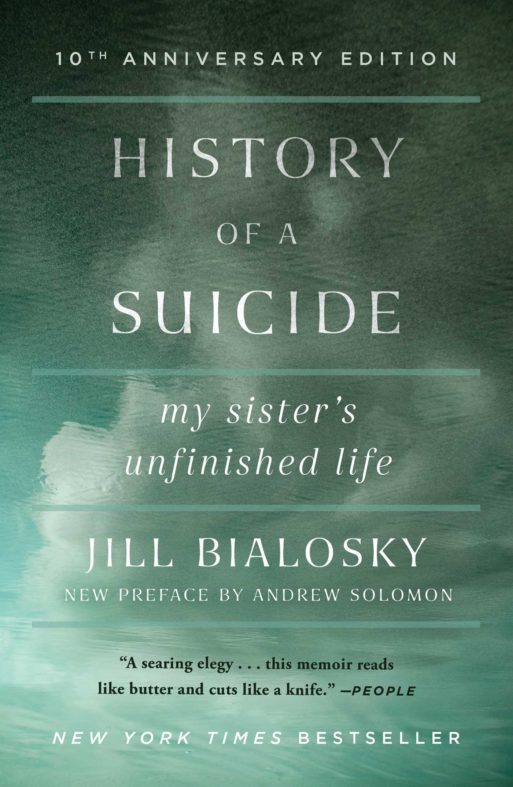 When news of Robin Williams’ suicide broke, I was already immersed in reading Jill Bialosky’s History of a Suicide, a beautiful, emotionally charged and highly informative memoir of her trying to come to terms and understand what led her youngest sister to commit suicide. Jill Bialosky grew up with a family scarred by several tragedies, including a mother who lost her own mother at age nine and became a widow at 24 with three young daughters—Bialosky being two at the time. Bialosky’s mother later remarries, only to endure her husband leaving her and divorce a few years later. The central subject of the memoir is Kim, Bialosky’s Mother’s daughter from her second marriage.
When news of Robin Williams’ suicide broke, I was already immersed in reading Jill Bialosky’s History of a Suicide, a beautiful, emotionally charged and highly informative memoir of her trying to come to terms and understand what led her youngest sister to commit suicide. Jill Bialosky grew up with a family scarred by several tragedies, including a mother who lost her own mother at age nine and became a widow at 24 with three young daughters—Bialosky being two at the time. Bialosky’s mother later remarries, only to endure her husband leaving her and divorce a few years later. The central subject of the memoir is Kim, Bialosky’s Mother’s daughter from her second marriage.
Unfortunately, Bialosky’s life continues to be plagued with tragedy—two babies born and then dying shortly afterwards—after Kim’s suicide at the age of 21. These series of tragedies—death of a father, abandonment of stepfather/Kim’s own father, Kim’s suicide, the birth and death of two babies within less than two years—allowed Bialosky ample opportunities to reflect on her own grief and loss and to perform research through the multitude of readings, both scientific and poetic, to help better understand everything, especially Kim’s suicide.
“Mourning the loss of a suicide is a different kind of grieving. It has little to do with the five stages of grief or with any known timetable. Grief is tangled up with complicated feelings of shame and stigma, unsettling feelings about the past, and guilt.”
Bialosky’s inspiration to write History of a Suicide happened when her adopted son was about to become a teenager—the same time everything with her sister, Kim, started falling apart and she spiraled down the path of suicide. This milestone made her realize her “responsibility as a mother made it imperative…[She] had to go back and excavate her history. [She] had to understand why she would take her own life and whether [she] could have stopped her.” The book, however, was far from easy for her to write, no matter how many years had passed since the suicide. As she puts it, “There were periods during which I could allow myself to think of Kim and other times when it would sink me. Time had formed a seal over the tenderness of my emotions. But from time to time the seal cracked. Mourning the loss of a suicide is a different kind of grieving. It has little to do with the five stages of grief or with any known timetable. Grief is tangled up with complicated feelings of shame and stigma, and unsettling feelings about the past and guilt.”
As a form of coping with her sister’s loss, Bialosky became obsessed with reading all forms of literature—scientific, psychological, fictional, poetic, etc.—in order to try to understand how her once ebullient and carefree sister became swallowed into such deep despair to the point of ending her life.
History of a Suicide’s layout includes a myriad of short essays divided into six parts. Some of these essays focus on the day Kim committed suicide; others focus on the past, including family history, and what could have led to the suicide happening. Some parts of the book focus on the present day and how Bialosky and her family members still struggle to understand and cope with the suicide over two decades later. As Bialosky says, in the early days, when she would talk about Kim, her “friends, meaning to help and offer sympathy, said stupid things. One of the most common was that suicide was her choice.” Throughout this book, we learn a great deal about how guilty Bialosky feels since she had been like a second mother to her half sister who was ten years younger. As a form of coping with the loss of her sister, Bialosky became obsessed with reading all forms of literature—scientific, psychological, fictional, poetic, etc.—in order to try to understand how her once ebullient and carefree sister became swallowed into such deep despair to the point of ending her life. She weaves significant quotes from these forms of literature throughout the book to help readers better understand the journey she endured to comprehend her sister’s route to suicide. Her goal with writing the book was also to give her sister “a proper mourning.”
I highly recommend History of a Suicide for those interested in understanding how incomprehensible the act of suicide is and consuming the grief can be for those left behind, even decades later. Bialosky engages her readers in all of the short essays through her masterful incorporation of a combination of personal, informative anecdotes about Kim and family members and excerpts of significant information she attained through her plethora of various readings whether they were scientific studies or poems. This book will leave you pondering philosophically about the importance of life as a whole, long after you finish reading it.
More SevenPonds posts about suicide:

 History of a Suicide: My Sister’s Unfinished Life by Jill Bialosky
History of a Suicide: My Sister’s Unfinished Life by Jill Bialosky



 John Mulaney’s “Funeral Planning” on Netflix: No Real Plan
John Mulaney’s “Funeral Planning” on Netflix: No Real Plan

 Composting Bodies Is Now Legal in a Dozen States
Composting Bodies Is Now Legal in a Dozen States














